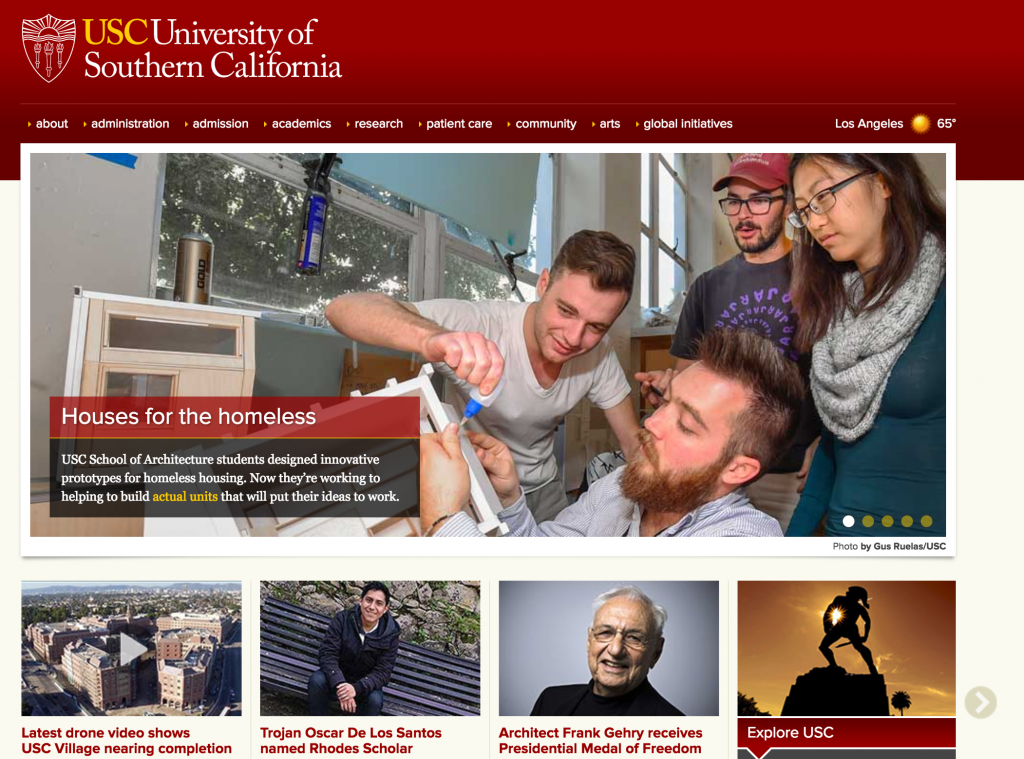Homeless Studio on USC’s front page!
Architecture students design houses for L.A.’s homeless Trojans apply their skills to social ills, designing prototypes for temporary shelters that could work in the real world By: Joanna Clay | Categorized: Social Impact When architecture…
Architecture students design houses for L.A.’s homeless
Trojans apply their skills to social ills, designing prototypes for temporary shelters that could work in the real world
By: Joanna Clay | Categorized: Social Impact
When architecture student Jayson Champlain set out to build his first house, he didn’t go to vendors or Home Depot.
He went to Vernon — scavenging items outside warehouses and in the garbage.
“One of the things we wanted to find was … an old truck camper shell,” Champlain said. “Luckily, we found one by the train tracks in Vernon, flipped up on the side of the road.”
The tiny house — with the shell for a roof — was built in the Madworkshop Homeless Studio at the USC School of Architecture.
In just a few months, a class of 11 fourth-year students came up with designs and prototypes for temporary homeless housing — from do-it-yourself nomadic designs, such as a bed that folds out of a shopping cart to tiny homes built with scavenged goods to a 92-square-foot prefabricated unit with built-in furniture.
And they could see their work in the real world.
Most recently, the class has been working with the city of Los Angeles and the nonprofit Hope of the Valley to create the prefabricated units for a 30-bed senior women’s shelter in the San Fernando Valley — a region that’s seen a 35 percent increase in homelessness in the last 12 months, said Hope of the Valley CEO Ken Craft.
“We’re getting firsthand experience showing that architecture isn’t just for those who can afford it,” said USC student Aleksandr Drabovskiy, “that it can be something that creates social good and changes the way people live their lives.”
Funding found
The course was funded by a grant from Santa Monica-based Madworkshop, a design education nonprofit. Professors Sofia Borges and Scott Mitchell are director and board member at the organization, respectively.
The course wanted to address the issue of temporary housing — the gap between living on the streets and living in permanent supportive housing.
“It can take two years to get in permanent housing,” Mitchell said. “We’re trying to get people off the street immediately.”
The workshop not only got the students thinking about applying their skills to social ills — but, for the majority, it was their first time building anything.
“They’re master builders now,” Borges said with a laugh.
A trio of projects
The workshop was broken up into three projects. There were mobile shelters made for street living, such as the shopping cart model or carts that fold out with beds and desks. Then there were the tiny houses, which they built in a week using scavenged materials they found all over Los Angeles — incorporating everything from refrigerators to screen doors. Both got them thinking of the needs of the homeless.
Lastly were the prefabricated units, which are intended to be easily mass-produced and transportable by truck and used on under-utilized land in Los Angeles, such as land that is yet to be developed. There would be an agreement, like a land lease, and then the units could be moved to a new location when development starts.
“It’s wonderful because it utilizes empty vacant land that otherwise is just sitting there,” Craft said. “Why not come up with a creative solution so that human beings have a place to sleep?”
On the rise
Homelessness has increased across Los Angeles County, but shelters are limited. For this reason, the county estimates 70 percent of the homeless are unsheltered, meaning they sleep on the streets or in tents.
In the San Fernando Valley alone, there are roughly 5,000 homeless people with only 900 beds to sleep in, Craft said.
The city of Los Angeles doesn’t require a conditional use permit for shelters of 30 beds or less, eliminating the need for community hearings, which means the shelter concept could be easily replicated and quickly, Mitchell said. The units would be pre-certified by the city.
The students have taken the reigns, scouting for land for the Valley shelter, finding a spot in Canoga Park. Right now, the nonprofit is looking to raise funds to negotiate the land lease and build the units, which Borges estimates would cost around $25,000 each.
For Borges, leading this class is a source of pride. Her brother, Daren, was homeless in Northern California, living off and on the streets for roughly 20 years. He died a couple years ago at the age of 42.
She hopes students realize their potential to help society with their work.
“With doctors, you take an oath to help everyone and I think as architects we should take a similar pledge,” Borges said. “We have the ability to create housing, create shelter — typically we do that for the most fortunate among us, rather than the least.”
On Dec. 7, the class is presenting a prototype of the units they propose for Hope of the Valley. They invited Midnight Mission, Downtown Women’s Center, Skid Row Housing Trust and the city’s Department of Building and Safety with the hope that one day, the units can be all over Los Angeles.
Read More Here: http://news.usc.edu/111494/architecture-students-design-houses-for-l-a-s-homeless/
- Date: December 2016
- Category: News

